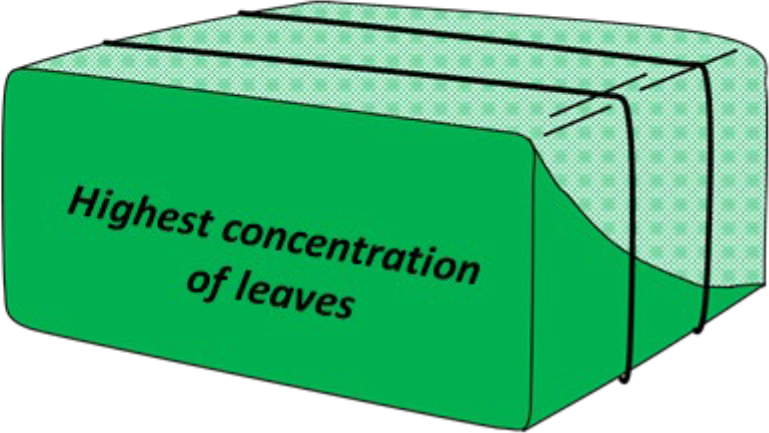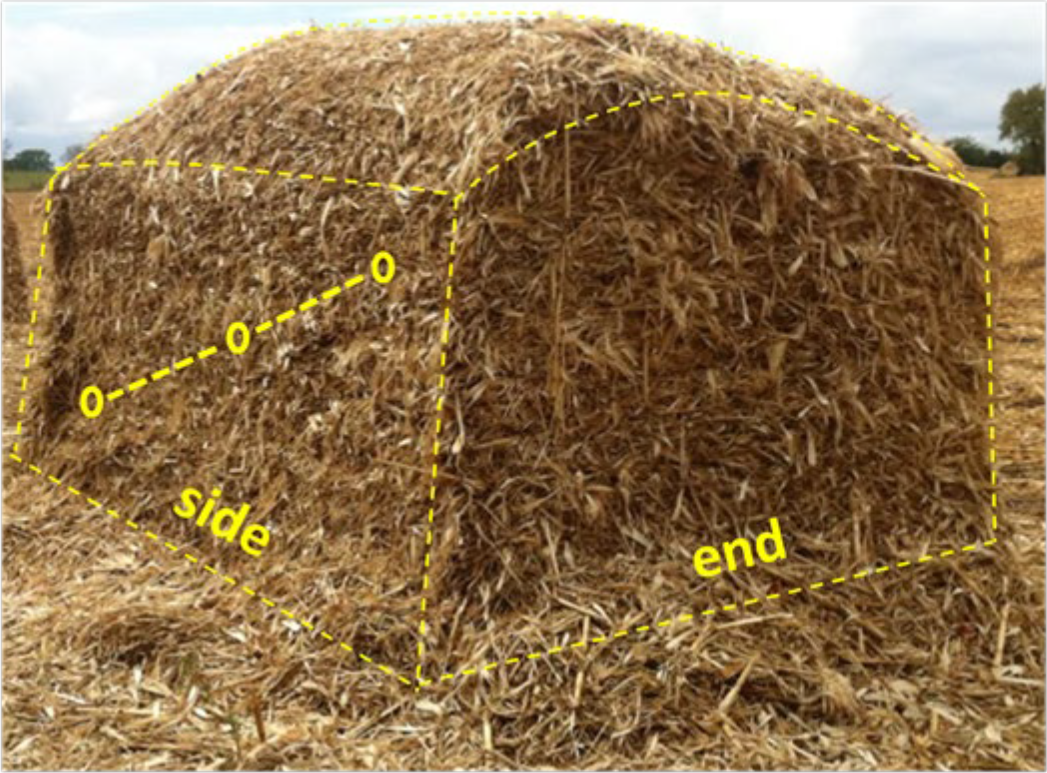⇦ Back to Livestock and Feedstuff Management Home
¶ Introduction
Good samples are the key to successful forage analysis. Laboratory analysis can determine the forage quality from the sample that is submitted, but the results are of little use if the sample does not actually represent the forage to be fed.
Improper sampling is the largest source of error in forage analysis. A representative sample needs to be collected from each “lot” of hay. These samples identify the quality variations that may occur across fields and during harvest.
¶ Represent the “Lot” of Hay
A “lot” of forage consists of the forage harvested from one field at the same cutting and maturity within about a 48-hour period. For example, a “lot” usually contains less than 100 tons of hay.
Uniformity is most important when defining a “lot” of forage. Hay from the same “lot” should be similar for the type of plants, field (soil type), cutting date, maturity, variety, type of harvest, weather during growth and harvest, additives, curing, storage conditions, and other characteristics.
Variation in any of these characteristics can cause substantial differences in forage value. Designate a new “lot” of hay when these characteristics differ between loads or fields.
¶ General Sampling Guidelines
Samples must closely resemble the entire “lot” of hay. Each sample must also represent only one “lot” of hay.
Sample hay from individual cuttings and fields separately. A separate sample is needed if the hay was rained on or is otherwise different.
The first cutting usually shows the greatest variability. If a mixture of cuttings or classes of hay will be fed, a proportional number of bales or stacks can be used from each class to approximate the feed offered to livestock.
Sample hay after it has been stored, two to four weeks before feeding begins. If the hay has heated, analyze samples for “heat-damaged protein”.
Avoid sampling moldy or decayed hay that will be discarded or would likely be refused by animals when fed free choice. Include moldy or decayed hay in the sample if the hay will be ground or purchased to accurately represent the “lot”.
A hay probe (like the Penn State forage sampler) is the best tool for sampling hay. Hand-grab samples do not provide consistently reliable results. Grab samples sometimes only contain a handful of leaves. More often, leaves are stripped from the stem, are left behind, and not included in the sample. Neither situation would accurately reflect the actual leaf-to-stem ratio of the hay lot.
Collect 15 to 20 subsamples (or cores) during sampling. The final sample size for submission to the laboratory should be about one to two quarts in volume.
¶ Leaf and Stem Distribution
Distribution of leaves, stems, weeds, and foreign material is not uniform in stored forages. Stratification of these components can bias the final samples.
Small square bales: When viewed from the end, leaves are primarily concentrated in the “tight” side of the bale (see Figure 1).
Large square bales: Uniform across the end face, but may vary throughout the length.
Round bales: Uniform on the circumference.
¶ Figure 1. Example of Stratification Within Small Square Bales

¶ Small Square Hay Bales
Use a hay probe to core into the end of each bale to be sampled, between the two twines (see Figure 2).
Sample at least 15 to 20 bales at random from each cutting and each field.
Probe to a depth of 12 to 18 inches. The outside inch of a small square bale contains about one-third of the total hay in that bale.
Probe in an upward direction to prevent moisture from entering the hay and causing spoilage.
Do not substitute flakes of hay for core samples. A flake may not even represent the bale it was selected from, due to internal variation.
¶ Figure 2. Sample Into the End of Square Bales

¶ Large Square Hay Bales
Sample a minimum of 10% of the bales from the “lot” to represent the “lot”. Do not sample less than five bales. Collect core samples from the ends of the bales, not the sides. Probe to a depth of 15 to 18 inches.
Collect two cores from each bale, if necessary, to obtain a final sample of 15 to 20 cores. Probe in an upward direction to prevent moisture from entering the hay and causing spoilage.
¶ Large Round Hay Bales
Round bales are normally stored outside and subjected to weathering. If the bales have been stored outside for a year or more, the top and bottom of the bale may have different quality due to weathering.
Collect samples two to four weeks before the hay is sold or before feeding begins, rather than sampling immediately after harvest.
Sample a minimum of 10% of the bales to represent the “lot”. Do not sample less than five bales.
Collect two cores from each bale, if necessary, to obtain a final sample of 15 to 20 cores. Probe in an upward direction to prevent moisture from entering the hay and causing spoilage.
Collect core samples from the sides of the bales, not the flat ends. Probe to a depth of 15 to 18 inches. About threefourths of the hay in a six-foot diameter bale is contained in the outer 18 inches (see Figure 3).
¶ Figure 3. Percentage of Hay in Layers of a 6-Foot Hay Bale

¶ Loose Hay Stacks
Make sure the hay is compressed enough for good sampling. Use a hay probe to collect at least three core samples from the sides of 5 to 6 stacks. Take cores in a diagonal line along the side because during cutting most of the leaves get thrown to the front and bottom of the stacker.
Take one core about two feet from the top edge of the stack, the second core about two feet from the ground, and the third from the center of the stack (see Figure 4).
¶ Figure 4. Sampling Pattern for "Loaf"-Type Loose Hay Stacks

¶ Chopped or Ground Hay
Collect about 10 to 15 small samples from each “lot” of hay routinely during grinding. Collect about one-fourth of the samples from the top half of the pile and the rest from the lower half.
Avoid losing fines while sampling. Collect hand-grab samples in an upward motion with the palm up and fingers extended to minimize loss of fines. Place small samples into one plastic bag and seal.
¶ Total Mixed Rations (TMR)
There are four main reasons for analyzing a total mixed ration:
- To compare the calculated ration to the fed ration,
- To check if the TMR is properly mixed,
- To see if cows are selecting their food, or
- To know more about an unknown ration
Mix the TMR using normal procedures and distribute in the bunk as normal. Sample the TMR immediately after distribution into the bunk line.
Unlike sampling individual feed ingredients, which can be sampled at any time, a TMR must be sample within about five minutes after delivery to the bunk. Animals begin to sort feed ingredients immediately after delivery and can alter the sample of the TMR submitted for analysis if it is collected later.
Collect ten sets of hand-grab samples at regular intervals along the entire bunk line. Collect samples from the top, middle, and bottom of the ration windrow in the bunk.
Do not squeeze or shake the hand-grab samples before placing them in the sampling bucket. Do not avoid oversized feedstuffs or large by-product feed ingredients during sampling.
Clip long forages (such as straws or grass hays) that do not break up during mixing. Cut them to a length of about one to two inches to avoid over-representing them in the final sample.
The sample bucket should contain two to three gallons of TMR when all of the hand-grab subsamples have been collected. Mix the bulk sample thoroughly and quarter to reduce it to the final sample volume of about one to two quarts.
If sorting by the animals is a concern, compare the particle size of the fresh TMR to that of the refused feed. This may explain discrepancies in the TMR analysis, especially if samples are not collected soon after feeding.
¶ Cubes or Pellets
Cubes or pellets are dense, bite-size feed packages. Because they are suitable for mechanized handling, cubes and pellets are generally dropped from an overhead elevator into a covered storage area forming a cone-shaped pile.
Collect a handful of cubes or pellets from at least 6 locations around the pile. Avoid collecting fines since they are only a small percentage of the total. Combine subsamples in a bucket and mix well.
¶ Pre-harvest Standing Forage
Sampling standing forage will help to determine if a field is ready to cut for hay or silage. Select sampling sites (clipping sites) randomly throughout the field to provide a representative sample. Walk in an “M” pattern throughout the field.
Clip and remove samples at harvest height at 8 to 10 regularly spaced locations. For a small field, this might mean every 20 steps, for a large field this might mean every 50 steps. Sample number should be increased for larger fields in order to obtain a better average.
Chop the collected forage into pieces 2 to 3 inches long. Mix thoroughly and place about one to two quarts of sample in a plastic bag and ship immediately to the laboratory.
¶ Pasture
Collecting samples from standing forage can help determine if any supplemental feed is required during grazing. Obtaining a representative sample from pastures is difficult because of variability in soil fertility, moisture, plant growth stage, and variation in plant types present.
In evenly grazed pastures, collect samples by establishing a grid plan. Collect the forage from a one-square foot area in 5 to 10 predetermined grid points, based on pasture size.
If there are large variations within the field, because of proximity to a water source running through or a hillside, collect multiple samples to best represent the variations within the pasture.
Chop the collected forage into pieces 2 to 3 inches long. Mix thoroughly and place about one quart of sample in a plastic bag and ship immediately to the laboratory.
¶ References
Anderson, Mader, & Kononoff. 2007. Sampling Feeds for Analysis. Pub. G331. Univ. of Nebraska Coop. Ext. Serv., Lincoln NE. 2 pg.
Glunk, Van Emon, & Malisani. 2016. Collecting a forage or feed sample for analysis. Pub MT201610AG. Montana State Univ. Extension, Bozeman MT. 4 pg.
Robinson, & Meyer. 2010. Total mixed ration (TMR) sampling protocol. Pub. 8413. Univ. of California, Dept. of Agric. & Nat. Res., Davis CA. 5 pg.
Undersander, et. al. 2005. Sampling hay, silage, and total mixed rations for analysis. A2309. Univ. of Wisconsin Coop. Ext. Serv., Madison WI. 8 pg.